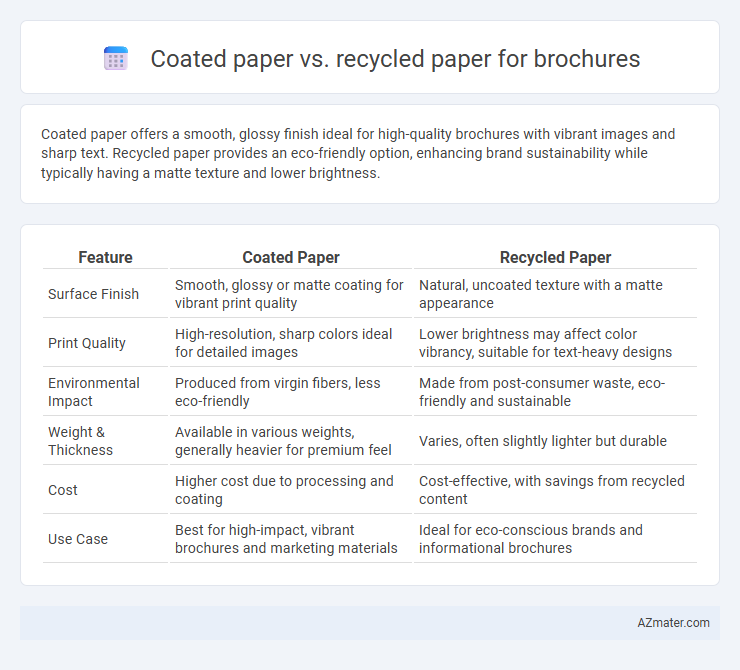Coated paper offers a smooth, glossy finish ideal for high-quality brochures with vibrant images and sharp text. Recycled paper provides an eco-friendly option, enhancing brand sustainability while typically having a matte texture and lower brightness.
Table of Comparison
| Feature | Coated Paper | Recycled Paper |
|---|---|---|
| Surface Finish | Smooth, glossy or matte coating for vibrant print quality | Natural, uncoated texture with a matte appearance |
| Print Quality | High-resolution, sharp colors ideal for detailed images | Lower brightness may affect color vibrancy, suitable for text-heavy designs |
| Environmental Impact | Produced from virgin fibers, less eco-friendly | Made from post-consumer waste, eco-friendly and sustainable |
| Weight & Thickness | Available in various weights, generally heavier for premium feel | Varies, often slightly lighter but durable |
| Cost | Higher cost due to processing and coating | Cost-effective, with savings from recycled content |
| Use Case | Best for high-impact, vibrant brochures and marketing materials | Ideal for eco-conscious brands and informational brochures |
Introduction to Brochure Paper Types
Coated paper delivers a smooth, glossy finish ideal for high-quality brochure printing, enhancing color vibrancy and sharp image reproduction. Recycled paper, made from post-consumer waste, supports environmental sustainability while offering a natural, matte texture preferred for eco-friendly branding. Choosing between coated and recycled paper depends on balancing visual impact with ecological considerations in promotional materials.
What is Coated Paper?
Coated paper features a surface layer of materials such as clay or calcium carbonate, enhancing smoothness, gloss, and ink holdout for sharp, vibrant images ideal for brochures. This paper type offers superior print quality and durability compared to uncoated or recycled paper, making it suitable for high-end marketing materials. While coated paper enhances visual impact, recycled paper is more environmentally friendly but often lacks the same brightness and finish.
What is Recycled Paper?
Recycled paper is produced from recovered paper fibers that have been reprocessed to minimize environmental impact, often resulting in reduced deforestation and lower energy consumption compared to virgin paper. Unlike coated paper, which has a glossy or matte finish for enhanced image sharpness and color vibrancy, recycled paper typically has a more natural texture and appearance. Selecting recycled paper for brochures supports sustainability efforts while maintaining adequate print quality for many marketing materials.
Visual Impact: Print Quality and Color Vibrancy
Coated paper delivers superior print quality and color vibrancy for brochures due to its smooth, glossy surface that enhances image sharpness and saturation. Recycled paper often exhibits a rougher texture and off-white tone, which can dull colors and reduce visual impact. For marketing materials requiring vivid visuals and crisp details, coated paper is generally preferred to maximize attractiveness and engagement.
Environmental Considerations
Coated paper offers vibrant color reproduction and smooth texture but often involves chemical treatments and a non-recyclable plastic coating, increasing environmental impact. Recycled paper reduces deforestation and energy consumption by reusing fibers, supporting sustainable practices and minimizing landfill waste. Choosing recycled paper for brochures aligns with eco-friendly values by lowering carbon footprint and conserving natural resources.
Durability and Handling
Coated paper offers superior durability with a smooth, protective surface that resists moisture and smudging, making it ideal for high-quality brochure printing and frequent handling. Recycled paper, while environmentally friendly, tends to be less robust, often exhibiting lower tear resistance and a rougher texture that can affect the brochure's longevity. Selecting coated paper ensures a professional finish and reliable handling performance for brochures intended for extended use or distribution.
Cost Comparison
Coated paper typically incurs higher costs than recycled paper due to added finishing processes like gloss or matte lamination, which enhance durability and print quality. Recycled paper is more budget-friendly, offering substantial savings by utilizing post-consumer fibers and reducing raw material expenses. Choosing recycled paper for brochures can lower production costs while supporting eco-friendly initiatives without significantly compromising print appeal.
Perception and Brand Image
Coated paper enhances brochure perception by delivering vibrant colors and a smooth finish, which conveys a premium, high-quality brand image. Recycled paper supports sustainability values and appeals to eco-conscious consumers, reflecting a brand's commitment to environmental responsibility. Choosing coated paper signals luxury and professionalism, while recycled paper fosters trust and authenticity through green marketing.
Suitability for Different Brochure Purposes
Coated paper offers a smooth, glossy finish ideal for high-quality photo printing, making it suitable for luxury or promotional brochures that require vibrant colors and sharp details. Recycled paper provides an eco-friendly option with a matte or natural texture, best suited for environmentally conscious brands or informational brochures where sustainability is prioritized over image vibrancy. Choosing between coated and recycled paper depends on the brochure's purpose, with coated paper enhancing visual impact and recycled paper emphasizing environmental responsibility.
Making the Right Choice for Your Brochure
Coated paper offers a smooth, glossy finish that enhances vibrant colors and sharp images, making it ideal for high-quality brochures aiming for visual impact. Recycled paper, made from post-consumer waste, provides an eco-friendly option that emphasizes sustainability without compromising readability or print quality. Choosing the right paper depends on balancing environmental priorities with the desired aesthetic and tactile experience of your brochure.

Infographic: Coated paper vs Recycled paper for Brochure
 azmater.com
azmater.com